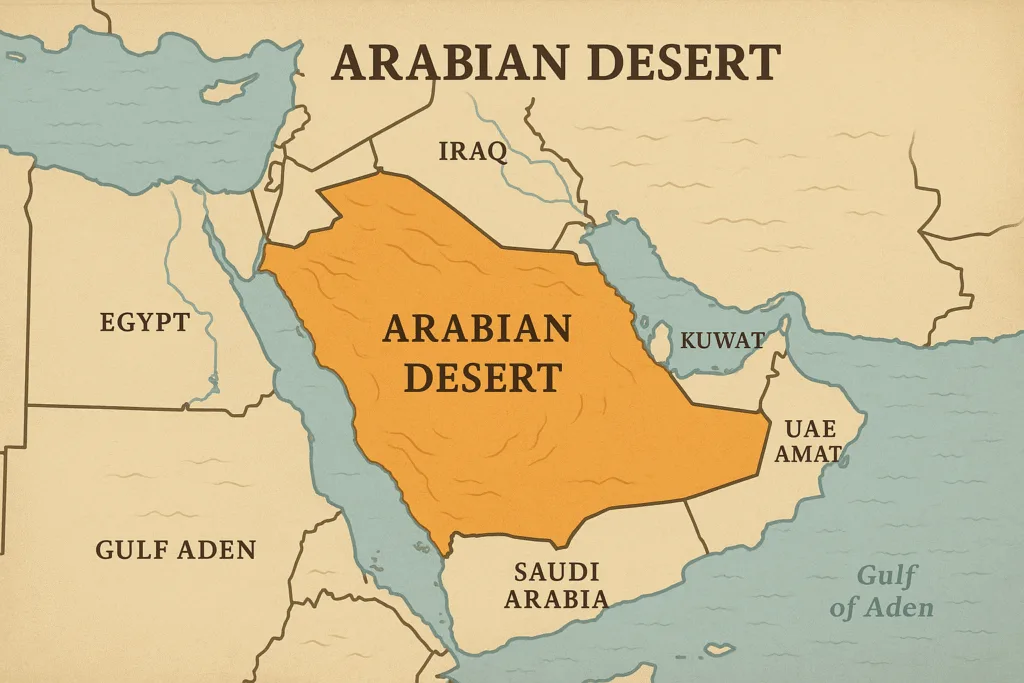Location & Continent
Continent: Asia
Country: China (Xinjiang Uyghur Autonomous Region)
Coordinates: 45°N, 86°E
Gurbantünggüt Desert – Map & Street View
Physical Features
Area: ~48,000 km² (the second-largest desert in China, after the Taklamakan)
Length: ~500 km (east–west)
Width: ~300 km (north–south)
Elevation: Generally 300–600 m above sea level; located in the Junggar Basin between the Tianshan and Altai Mountains
Climate & Precipitation
Temperature: Summer highs up to 45 °C; winter lows can fall below −25 °C
Precipitation: 70–150 mm annually, with occasional snowfall; semi-arid cold desert climate with high evaporation rates
Ecological Features
Ecozone: Palearctic (cold desert and steppe transition)
Biome: Temperate desert and semi-arid steppe
Ecoregions: Dzungarian Basin Desert, Northern Xinjiang Semi-Desert, Gurbantünggüt Sand Sea
Flora & Fauna
Flora: Dense patches of saxaul (Haloxylon ammodendron), Calligonum, Artemisia, Salsola, and Ephedra species; ephemeral wildflowers bloom briefly after spring rains
Fauna: Goitered gazelles, red foxes, jerboas, desert hares, monitor lizards, hedgehogs, and numerous reptiles and birds; occasional wolves and eagles hunt in the region
Geology & Notable Features
Geology: Composed of stabilized dunes, loess plains, and ancient alluvial fans of the Junggar Basin; much of the sand is fixed by vegetation, unlike the shifting dunes of southern deserts
Notable Features: Karamay oil fields (major petroleum region), Jiangjunmiao Dinosaur Fossil Site, Fukang Meteorite discovery area, and the unique semi-stabilized dune systems studied for desertification control
Introduction
The Gurbantünggüt Desert, located in the Xinjiang Uygur Autonomous Region of China, is an extraordinary expanse of arid land that showcases the unique characteristics of desert ecosystems. Covering approximately 48,800 square kilometers, it ranks as one of the largest deserts in China and features a variety of landscapes, including dunes, salt flats, and rugged terrain. This article dives into the geography, climate, biodiversity, and cultural significance of the Gurbantünggüt Desert.
Geography
The Gurbantünggüt Desert is predominantly bordered by the Ulu Murat River to the north and the Taklamakan Desert to the south. Its coordinates are approximately 44° N latitude and 85° E longitude. The desert is characterized by:
- Sand Dunes: Towering dunes that can reach heights of up to 200 meters.
- Sandy Plains: Vast areas of desert floor, interspersed with salt flats and gravel plains.
- Mountain Range Influence: The Tarbagatai and Altai mountain ranges provide a geological backdrop, influencing local weather patterns.
Climate
The climate of the Gurbantünggüt Desert is classified as a cold desert climate. The key features include:
- Temperature Variability: Summer temperatures can soar above 40°C, while winter temperatures plummet to -30°C.
- Limited Precipitation: The desert receives an average of less than 200 mm of rain annually, primarily falling between April and June.
This extreme climate shapes the ecosystem, with flora and fauna specially adapted to survive in harsh conditions.
Biodiversity
Although the Gurbantünggüt Desert may seem barren at first glance, it supports a remarkable variety of life:
- Flora: Dominated by salt-tolerant plants, such as tamarisk and halophytes.
- Fauna: Home to endemic species like the Gurbantünggüt Gazelle and various reptiles and rodents.
Comparative Ecosystem Characteristics
| Feature | Gurbantünggüt Desert | Taklamakan Desert | Sahara Desert |
|---|---|---|---|
| Area (sq km) | 48,800 | 337,000 | 9,200,000 |
| Annual Rainfall (mm) | Less than 200 | Less than 100 | 100 to 250 |
| Temperature Range (°C) | -30 to 40 | -20 to 50 | 0 to 50 |
Cultural Significance
The Gurbantünggüt Desert plays a role beyond its geographical and biological attributes. The desert is rich in the cultural heritage of the Uyghur people, who have adapted their lifestyles to the challenging landscape. Additionally, the region contains historical trade routes of the Silk Road, which were pivotal for cultural exchange and commerce.
Conservation Issues
Despite its harsh climate, the Gurbantünggüt Desert faces several environmental challenges:
- Climate Change: Alterations in temperature and precipitation patterns affect the fragile desert ecosystem.
- Human Activities: Overgrazing and urban encroachment threaten the native flora and fauna.
Conservation efforts are crucial to preserving this unique desert ecosystem for future generations.
Conclusion
The Gurbantünggüt Desert is a remarkable testament to resilience in nature. It showcases a unique blend of harsh environmental conditions and a rich cultural heritage. Further research and conservation efforts are essential to maintain its biodiversity and significance in the context of both natural science and human history.
References
Government / Official Sources
Chinese Academy of Sciences — “Vegetation patterns and dune stabilization in the Gurbantünggüt Desert”
China Meteorological Administration — “Climate conditions of the Junggar Basin and Gurbantünggüt Desert”
UNESCO — “Silk Roads: the Routes Network of Chang’an–Tianshan Corridor (Northern Xinjiang, Dzungarian Basin)”
University Sources
Lanzhou University — “Aeolian processes and dune stabilization mechanisms in the Gurbantünggüt Desert, China”
Chinese Academy of Sciences / Springer — “Vegetation dynamics and climate feedbacks in the Gurbantünggüt Desert”


